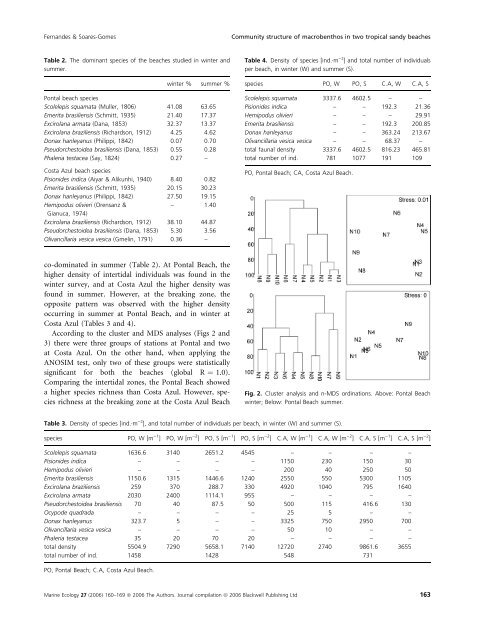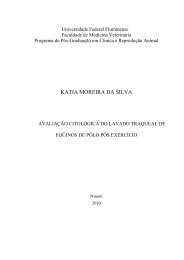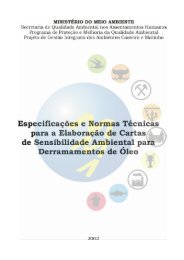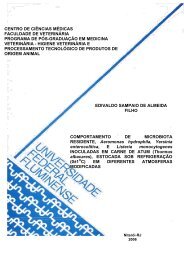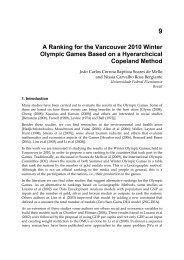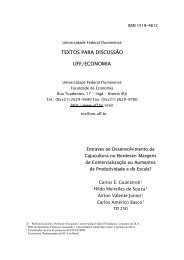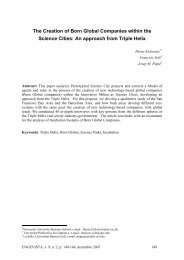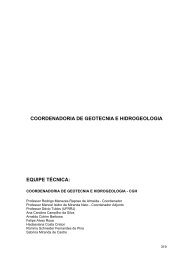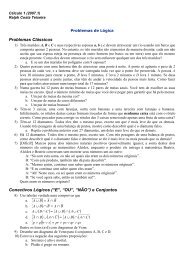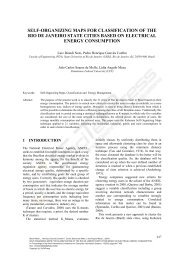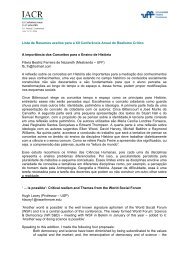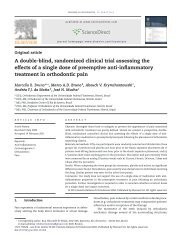Community structure of macrobenthos in two tropical sandy ... - UFF
Community structure of macrobenthos in two tropical sandy ... - UFF
Community structure of macrobenthos in two tropical sandy ... - UFF
Create successful ePaper yourself
Turn your PDF publications into a flip-book with our unique Google optimized e-Paper software.
Fernandes & Soares-Gomes<br />
<strong>Community</strong> <strong>structure</strong> <strong>of</strong> <strong>macrobenthos</strong> <strong>in</strong> <strong>two</strong> <strong>tropical</strong> <strong>sandy</strong> beaches<br />
Table 2. The dom<strong>in</strong>ant species <strong>of</strong> the beaches studied <strong>in</strong> w<strong>in</strong>ter and<br />
summer.<br />
w<strong>in</strong>ter % summer %<br />
Pontal beach species<br />
Scolelepis squamata (Muller, 1806) 41.08 63.65<br />
Emerita brasiliensis (Schmitt, 1935) 21.40 17.37<br />
Excirolana armata (Dana, 1853) 32.37 13.37<br />
Excirolana braziliensis (Richardson, 1912) 4.25 4.62<br />
Donax hanleyanus (Philippi, 1842) 0.07 0.70<br />
Pseudorchestoidea brasiliensis (Dana, 1853) 0.55 0.28<br />
Phaleria testacea (Say, 1824) 0.27 –<br />
Costa Azul beach species<br />
Pisionides <strong>in</strong>dica (Aiyar & Alikunhi, 1940) 8.40 0.82<br />
Emerita brasiliensis (Schmitt, 1935) 20.15 30.23<br />
Donax hanleyanus (Philippi, 1842) 27.50 19.15<br />
Hemipodus olivieri (Orensanz &<br />
– 1.40<br />
Gianuca, 1974)<br />
Excirolana braziliensis (Richardson, 1912) 38.10 44.87<br />
Pseudorchestoidea brasiliensis (Dana, 1853) 5.30 3.56<br />
Olivancillaria vesica vesica (Gmel<strong>in</strong>, 1791) 0.36 –<br />
Table 4. Density <strong>of</strong> species [<strong>in</strong>d.Æm )2 ] and total number <strong>of</strong> <strong>in</strong>dividuals<br />
per beach, <strong>in</strong> w<strong>in</strong>ter (W) and summer (S).<br />
species PO, W PO, S C.A, W C.A, S<br />
Scolelepis squamata 3337.6 4602.5 – –<br />
Pisionides <strong>in</strong>dica – – 192.3 21.36<br />
Hemipodus olivieri – – – 29.91<br />
Emerita brasiliensis – – 192.3 200.85<br />
Donax hanleyanus – – 363.24 213.67<br />
Olivancillaria vesica vesica – – 68.37 –<br />
total faunal density 3337.6 4602.5 816.23 465.81<br />
total number <strong>of</strong> <strong>in</strong>d. 781 1077 191 109<br />
PO, Pontal Beach; CA, Costa Azul Beach.<br />
co-dom<strong>in</strong>ated <strong>in</strong> summer (Table 2). At Pontal Beach, the<br />
higher density <strong>of</strong> <strong>in</strong>tertidal <strong>in</strong>dividuals was found <strong>in</strong> the<br />
w<strong>in</strong>ter survey, and at Costa Azul the higher density was<br />
found <strong>in</strong> summer. However, at the break<strong>in</strong>g zone, the<br />
opposite pattern was observed with the higher density<br />
occurr<strong>in</strong>g <strong>in</strong> summer at Pontal Beach, and <strong>in</strong> w<strong>in</strong>ter at<br />
Costa Azul (Tables 3 and 4).<br />
Accord<strong>in</strong>g to the cluster and MDS analyses (Figs 2 and<br />
3) there were three groups <strong>of</strong> stations at Pontal and <strong>two</strong><br />
at Costa Azul. On the other hand, when apply<strong>in</strong>g the<br />
ANOSIM test, only <strong>two</strong> <strong>of</strong> these groups were statistically<br />
significant for both the beaches (global R ¼ 1.0).<br />
Compar<strong>in</strong>g the <strong>in</strong>tertidal zones, the Pontal Beach showed<br />
a higher species richness than Costa Azul. However, species<br />
richness at the break<strong>in</strong>g zone at the Costa Azul Beach<br />
Fig. 2. Cluster analysis and n-MDS ord<strong>in</strong>ations. Above: Pontal Beach<br />
w<strong>in</strong>ter; Below: Pontal Beach summer.<br />
Table 3. Density <strong>of</strong> species [<strong>in</strong>d.Æm )2 ], and total number <strong>of</strong> <strong>in</strong>dividuals per beach, <strong>in</strong> w<strong>in</strong>ter (W) and summer (S).<br />
species PO, W [m )1 ] PO, W [m )2 ] PO, S [m )1 ] PO, S [m )2 ] C.A, W [m )1 ] C.A, W [m )2 ] C.A, S [m )1 ] C.A, S [m )2 ]<br />
Scolelepis squamata 1636.6 3140 2651.2 4545 – – – –<br />
Pisionides <strong>in</strong>dica – – – – 1150 230 150 30<br />
Hemipodus olivieri – – – – 200 40 250 50<br />
Emerita brasiliensis 1150.6 1315 1446.6 1240 2550 550 5300 1105<br />
Excirolana braziliensis 259 370 288.7 330 4920 1040 795 1640<br />
Excirolana armata 2030 2400 1114.1 955 – – – –<br />
Pseudorchestoidea brasiliensis 70 40 87.5 50 500 115 416.6 130<br />
Ocypode quadrada – – – – 25 5 – –<br />
Donax hanleyanus 323.7 5 – – 3325 750 2950 700<br />
Olivancillaria vesica vesica – – – – 50 10 – –<br />
Phaleria testacea 35 20 70 20 – – – –<br />
total density 5504.9 7290 5658.1 7140 12720 2740 9861.6 3655<br />
total number <strong>of</strong> <strong>in</strong>d. 1458 1428 548 731<br />
PO, Pontal Beach; C.A, Costa Azul Beach.<br />
Mar<strong>in</strong>e Ecology 27 (2006) 160–169 ª 2006 The Authors. Journal compilation ª 2006 Blackwell Publish<strong>in</strong>g Ltd 163


